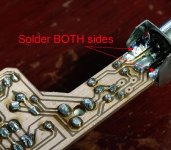cj7hawk
Veteran Member
I don't have my CNC set up at the moment, but have to make some new PCBs in the next month for a customer, so when I do I'll CNC up some extra PCBs of this and let's see if we can work out how to ship these to the US as a letter so I can figure the cost of shipping a single PCB by itself.
Theoretically, I should be able to send it so you can just solder it up and pop it out of the holder... After all, that's how I made them. I'll print up the extra spacers for the edge connector also so you don't have to judge and solder carefully.
But give me a little while since I'm not sure when I'll get around to the PCB making part of the project.
It won't be tinned, but it should solder up OK. And IIRC, your soldering skills are pretty good.
Theoretically, I should be able to send it so you can just solder it up and pop it out of the holder... After all, that's how I made them. I'll print up the extra spacers for the edge connector also so you don't have to judge and solder carefully.
But give me a little while since I'm not sure when I'll get around to the PCB making part of the project.
It won't be tinned, but it should solder up OK. And IIRC, your soldering skills are pretty good.






